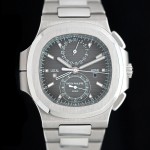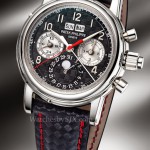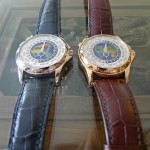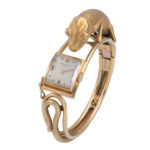In-Depth: Patek Philippe Grand Complication with Double Split-Chronographs Ref. 767
An incredible, landmark pocket watch.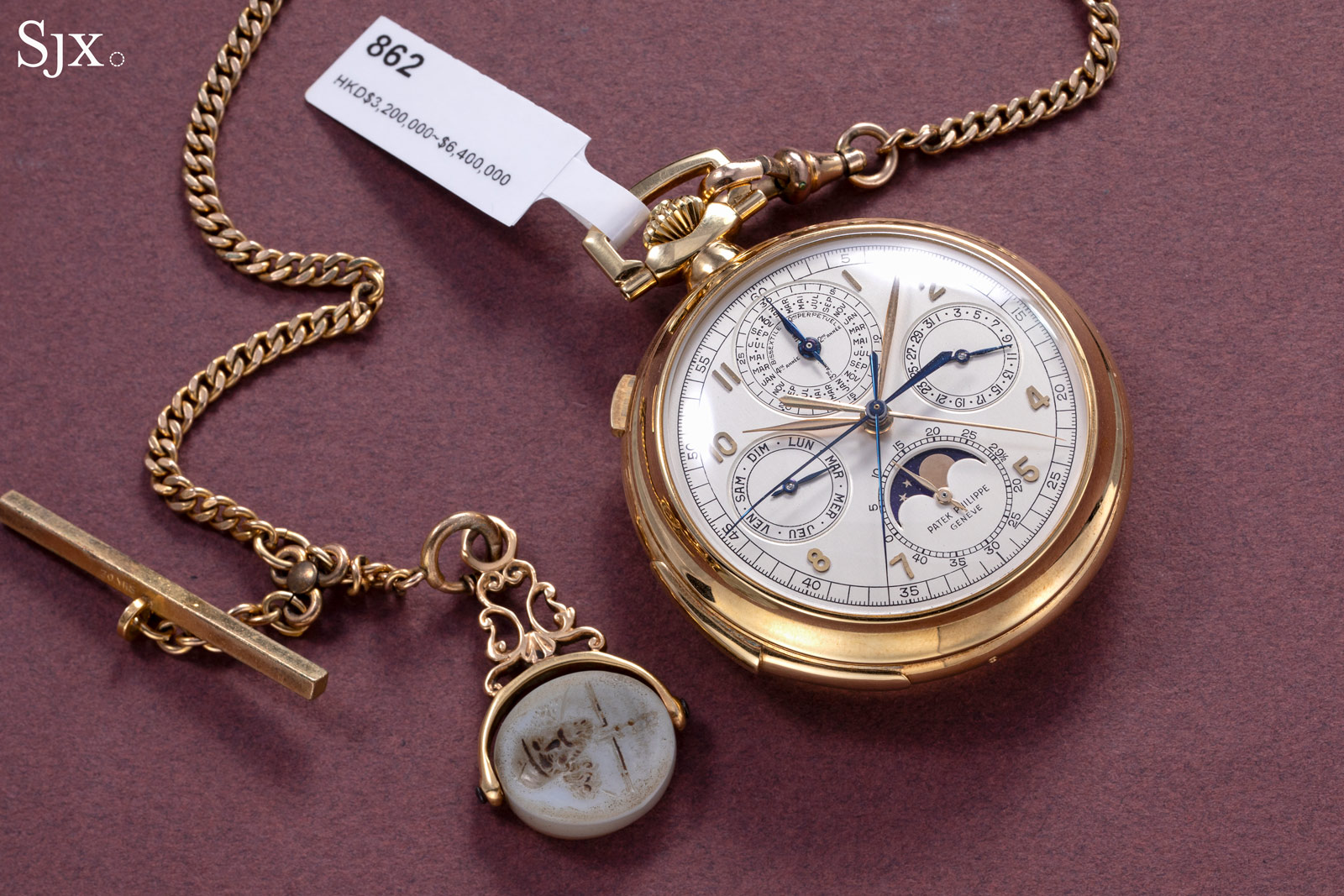
One of the most fascinating timepieces in Phillips’ upcoming Hong Kong auction is the Patek Philippe grand complication pocket watch ref. 767. Made in 1950 and sold in 1952, this one-of-a-kind pocket watch boasts a minute repeater, perpetual calendar, and double split-seconds chronograph. More accurately, it is a mono-pusher, double split-seconds, or even triple-split seconds.
This ref. 767 features not two, but three, chronograph seconds hands. As a result, it can simultaneously measure three elapsed times of up to one minute. The complication is possibly unique amongst Patek Philippe watches.
A historically significant watch in itself, this ref. 767 also has notable provenance: it once belonged to Seth Atwood, the American industrialist who founded the now-closed Time Museum. According to Philips, this ref. 767 was Atwood’s everyday watch, not surprising since he was a legendary collector of his day with a collection that included the Patek Philippe Graves Supercomplication and the Duc d’Orléans Breguet Sympathique.
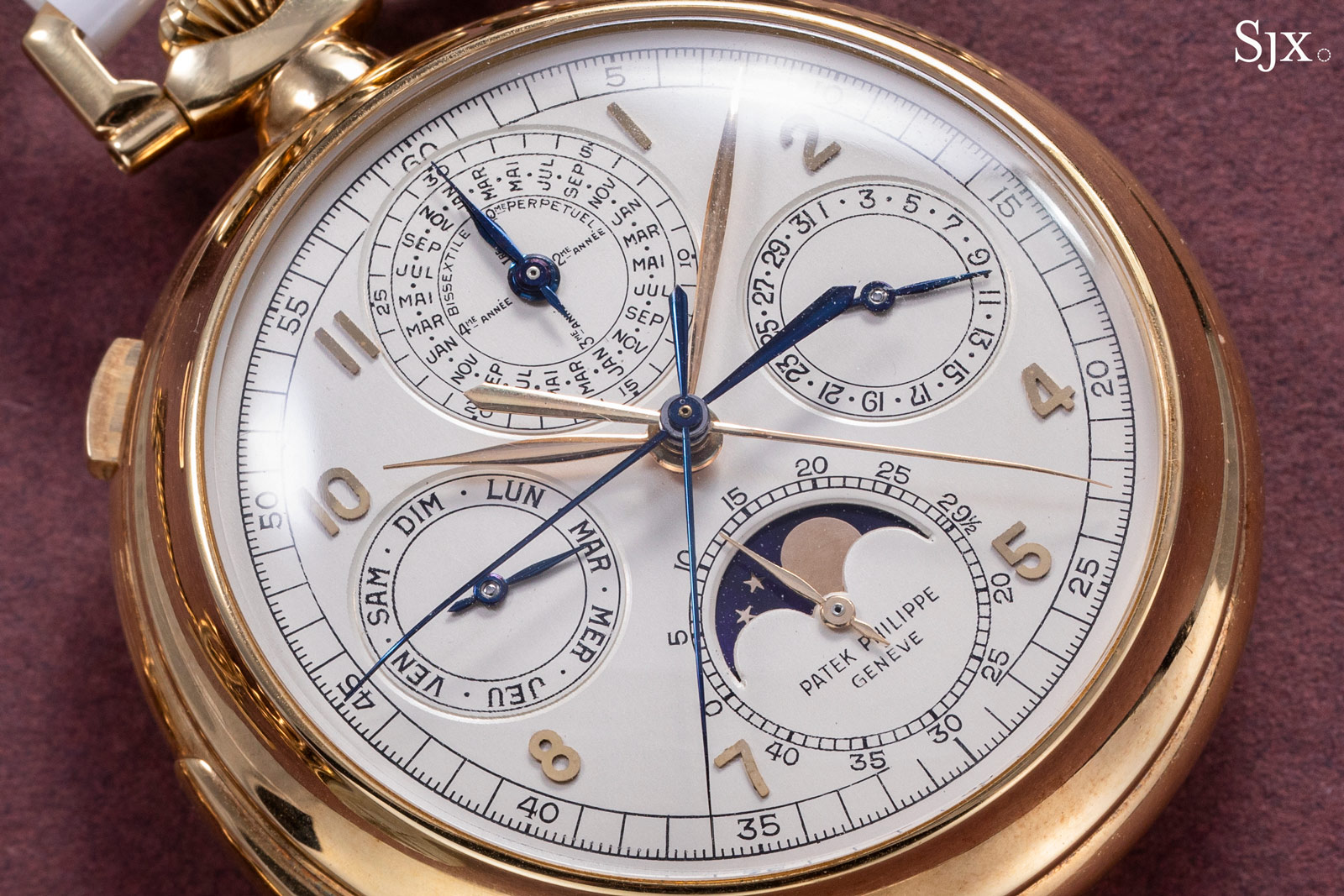
Three seconds hands, two in blued steel and one in gold
Initial thoughts
I’ve been impressed by many pocket watches – some that come to include a Patek Philippe observatory tourbillon and the Philippe Dufour Grande Sonnerie – but I’ve rarely been surprised. This ref. 767 was, however, entirely unexpected.
When it was first described to me, I was confused and immediately thought of the Lange Double Split. But as it turns out, this is entirely different and spectacularly unique. The three seconds hands on the dial are impressive and surprising.
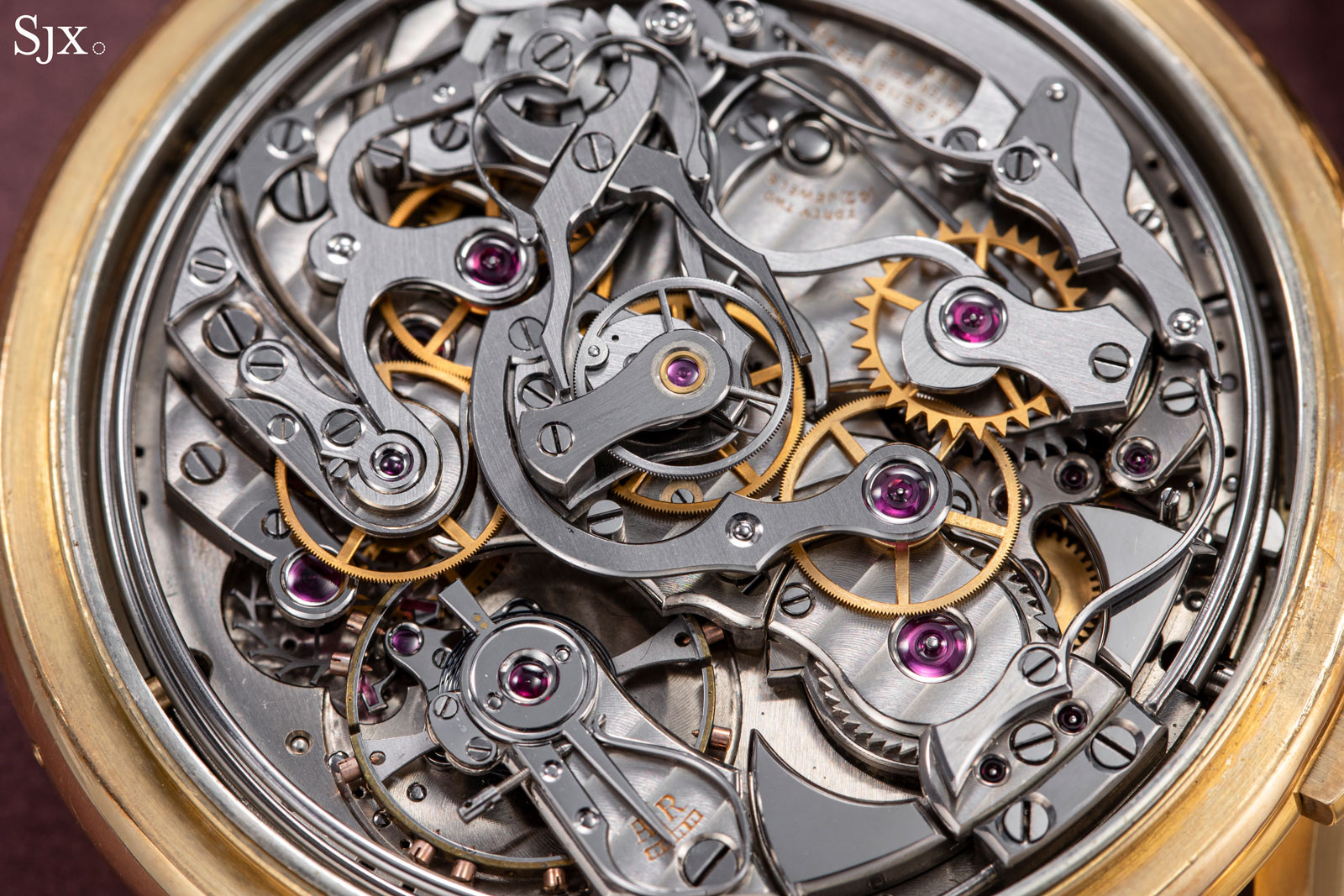

The split-seconds mechanism on the back of the movement
The concept of a double split-seconds is exceedingly simple, yet this watch is unique in its ability to measure triple elapsed times, even with Patek Philippe’s impressive repertoire of complications spanning almost two centuries.
Note the crucial different between this and the Lange’s modern-day offerings of the Double Split and Triple Split. The German watchmaker’s chronographs both record twin elapsed times (of up to one minute for the former and 30 minutes for the latter), but this ref. 767 can measure three sets of elapsed times.
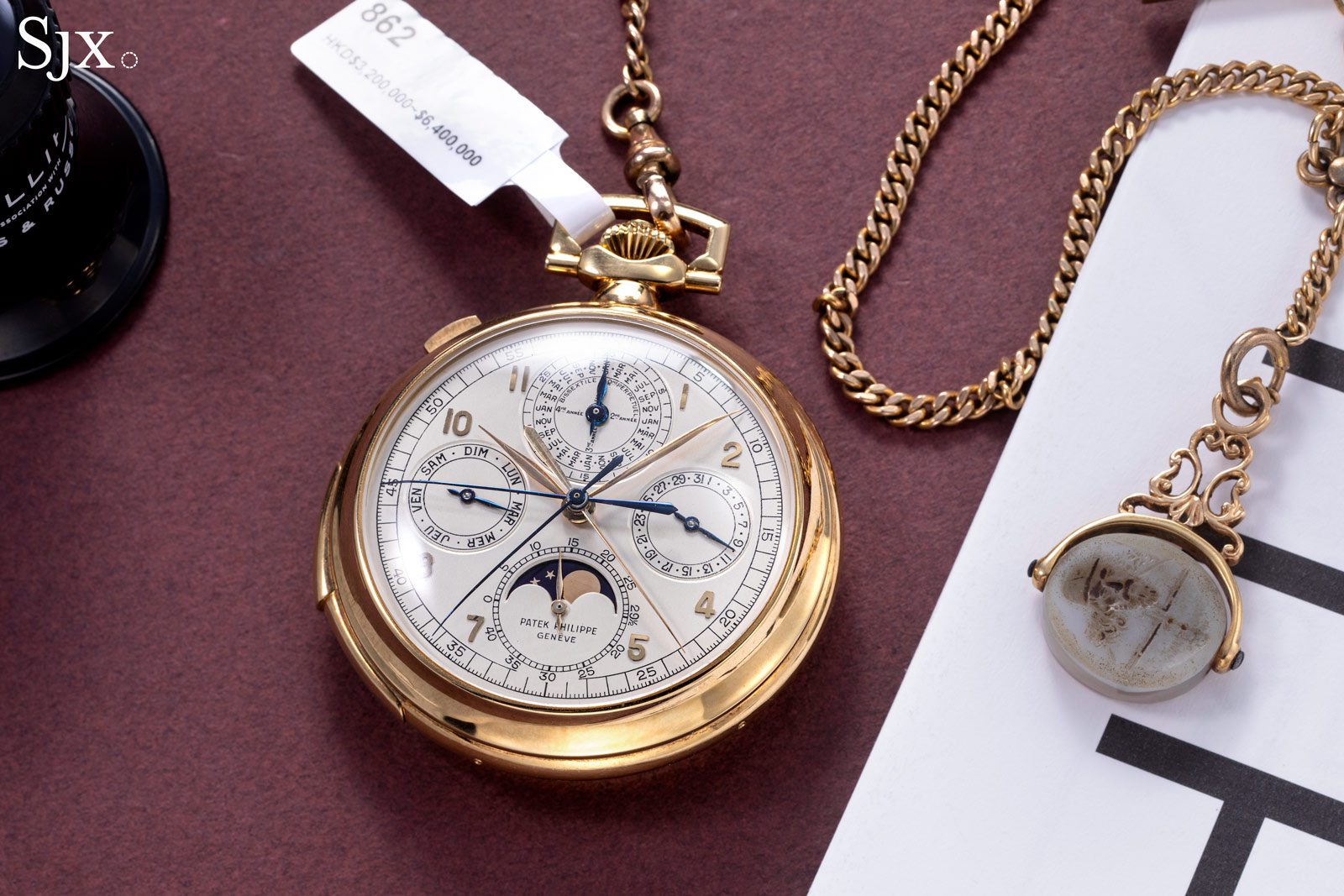
Since the concept is simple, the mechanics behind it are also straightforward. Patek Philippe didn’t invent the triple split-seconds, but it arguably executed it better than anyone else. Originally a Victorin Piguet ebauche, the movement is elegantly and gorgeously executed.
Interestingly, the movement doesn’t give away its unique function unless examined closely. In fact, when viewed from the back, the movement looks like an ordinary split-seconds chronograph. That’s because of the unusual movement construction that was a signature of the ebauche supplier.
Why the double split-seconds not been implemented in a wristwatch yet? Who knows. But with this watch now well documented here, I expect a similar wristwatch will eventually arrive. In fact, the peculiar architecture of the movement inside this ref. 767 (explained further down) brings to mind the modern-day ref. 5208.
And as an aside, the fact that Seth Atwood once owned this – and used it as his everyday watch – adds to its allure. He was clearly a horologist of the finest order and it is practically a given that he truly understood how special this watch is.
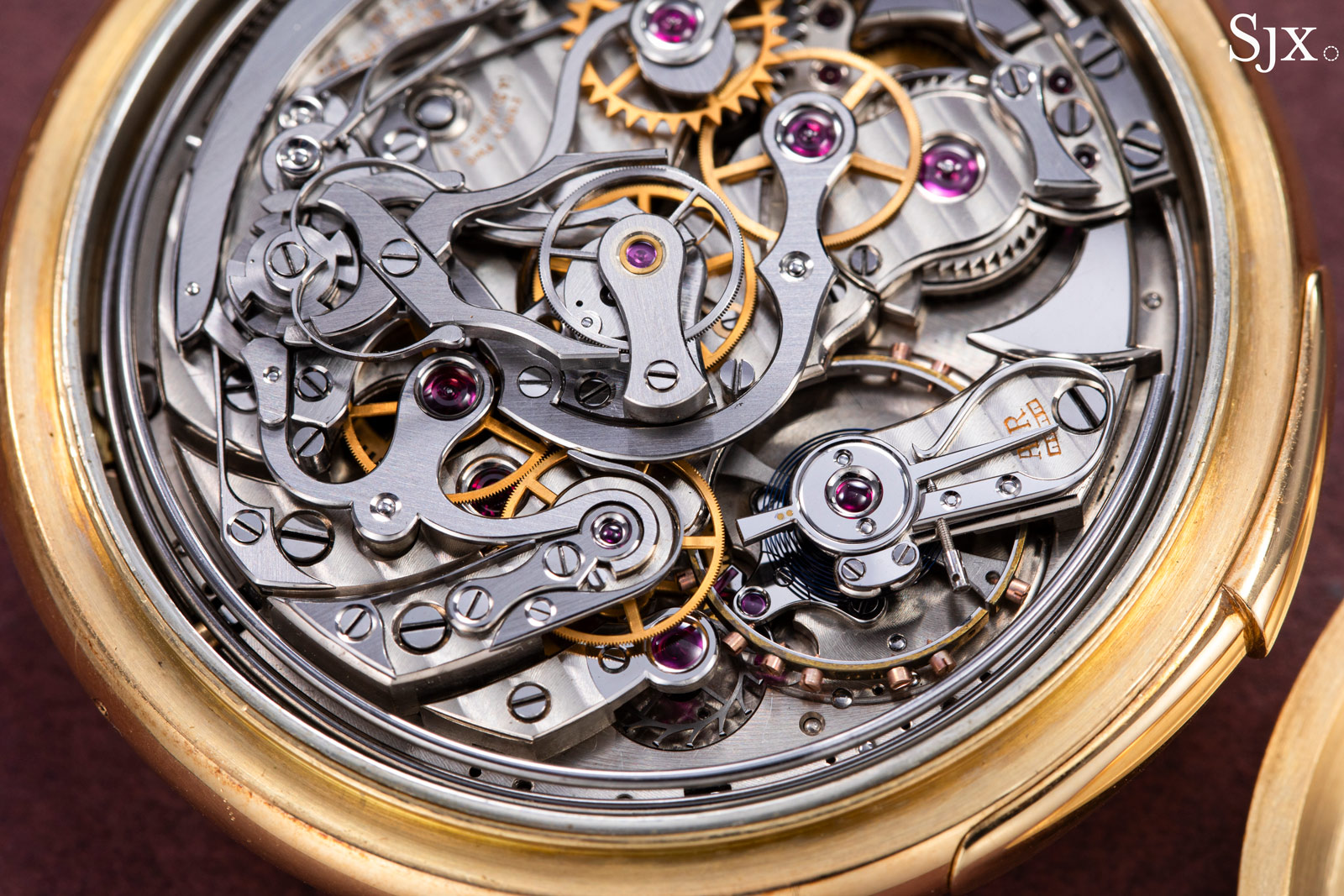
The only one known
Introduced in 1951, the ref. 767 is a grande complication according to the traditional definition: it combines calendar, striking, and time-measuring functions. Seven examples of the ref. 767 are known today, with each having a different dial, though all are equipped with similar movements dating to the 1920s that remained unsold in Patek Philippe’s inventory. Six of them are identical in terms of functions, save for this possibly unique example.
According to Phillips, this ref. 767 was made in 1950, making it the earliest known example (with the last known specimen dating to 1965). Sold two years later, presumably in France given the French calendar indications, this ref. 767 was not exactly lost, but certainly forgotten for a long time.
It was last publicly documented in the 1982 book Patek Philippe Geneve by Martin Huber and Alan Banbery, where it was still in Atwood’s possession. How Atwood came to own this pocket watch is unknown, but the watch has been owned by the current owner for decades.

The months and leap year displays are in French
On its face, the ref. 767 is a typical watch of the period. With its moon phase at six o’clock, this example is almost identical to another known ref. 767 with an ordinary split-seconds chronograph.
The silvered dial has applied Arabic numerals and leaf-shaped hands, with the calendar arranged in four sub-dials, the 30-minute register at 12 o’clock, and constant seconds at six.

With only one split-seconds activated, hence two seconds hands visible
Even the case is seemingly ordinary with a minute repeater slide at eight o’clock, and a chronograph pusher at 11 o’clock and another co-axial with the crown.
The pushers, however, work a little differently from a conventional split-seconds. The button in the crown starts the chronograph, while the pusher at 11 o’clock stops the first split-seconds hand. Pressing the 11 o’clock pusher once again then stops the second split-seconds hand. The final seconds hand is then stopped by the pusher in the crown, resulting in a total of up of three elapsed times.

The split times indicated above are 23.8, 36.0, and 45.0 seconds
Executed in the “moderne” design common for Patek Philippe pocket watches of the mid-20th century, the 50 mm yellow gold case has a plain snap-on back. At a glance it is similar to the cases of other ref. 767s known.
However, all other ref. 767s have cases made by Antoine Gerlach. This ref. 767, however, is unique in having a case made by Emile Vichet, the case maker better known for having supplied cases for the ref. 1518 and first-series ref. 2499.
Although a comparison of the case heights are not currently available, it is likely that this ref. 767 has a taller case than the standard model since the additional split-seconds function requires more vertical room.
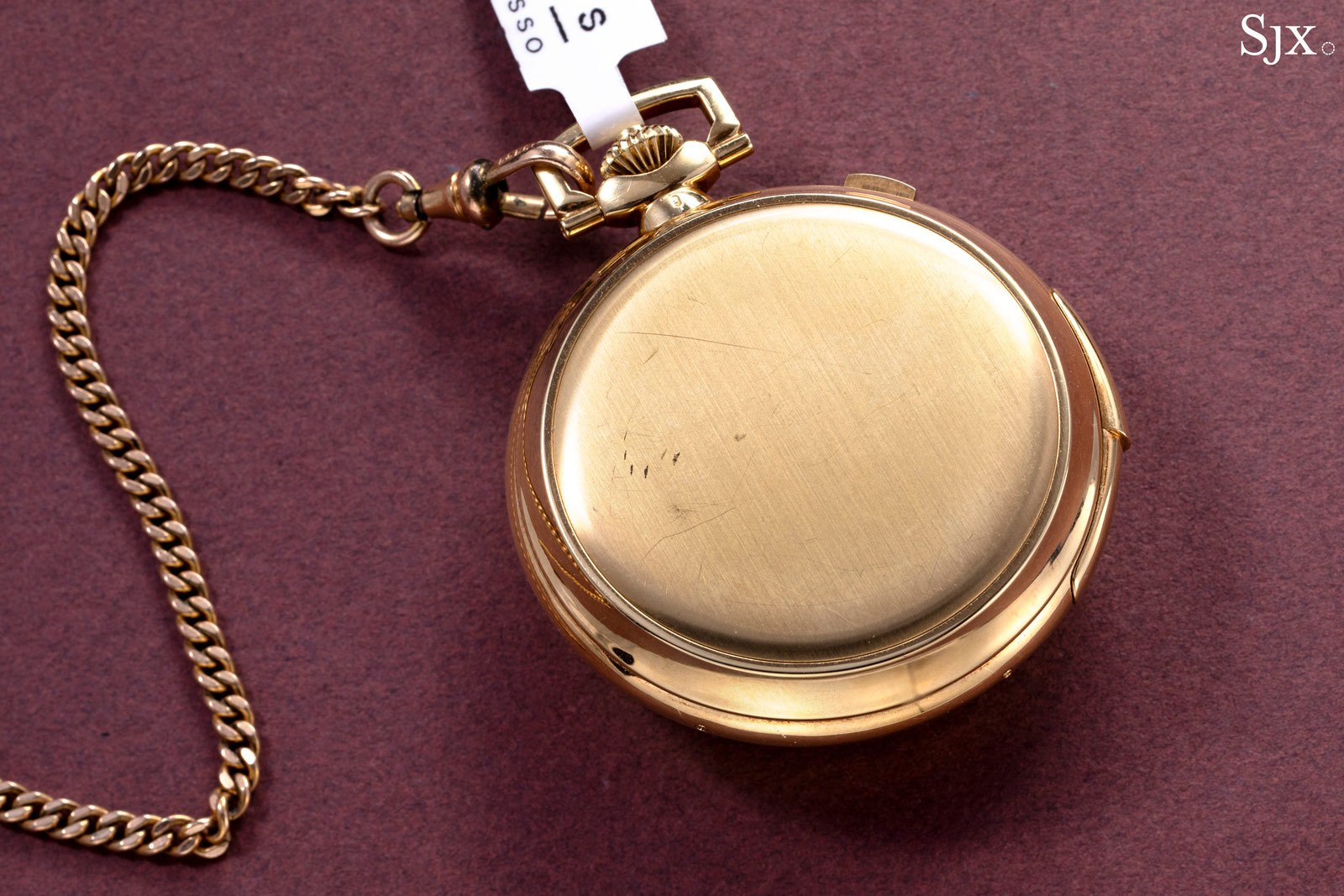

The “9” key hallmark indicates Vichet was the case maker
Under the back sits a 17”’ movement based on a Victorin Piguet ebauche, just like other ref. 767s. And like other ref. 767s, this is equipped with a dial-side split-seconds mechanism.
But because it’s a double split-seconds, it has an additional split-seconds mechanism on the back. In other words, most of the movement is sandwiched in between two split-seconds mechanisms.

Because one of the split-seconds mechanisms is concealed under the dial, the movement viewed from the back resembles a conventional rattrapante chronograph – but with a twist in the column wheels.
A pair of superimposed wheels sit in the centre of the movement, one for each elapsed seconds hand. The upper wheel is flanked by a pair of clamps that close in to stop the wheel when the split-seconds hand is stopped.
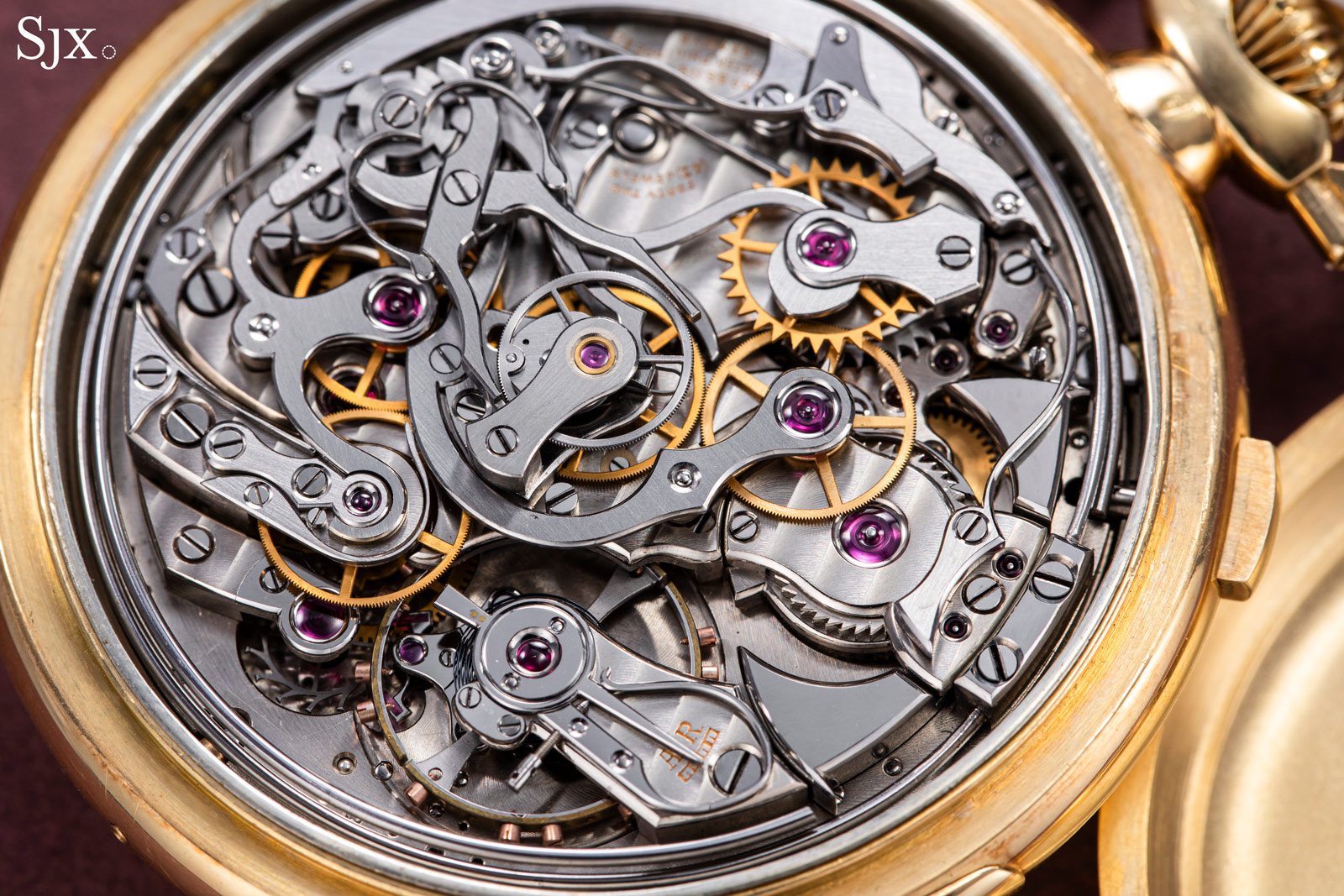

The split-seconds wheel with its clamps
Because there are two sets of chronograph wheels, two column wheels are required. But here the column wheels are thoughtfully stacked on top of each other in a more elegant solution than have two column wheels positioned separately.
And hidden underneath the dial, and also under the perpetual calendar module, is a single column wheel and its corresponding chronograph levers for the other split-seconds.
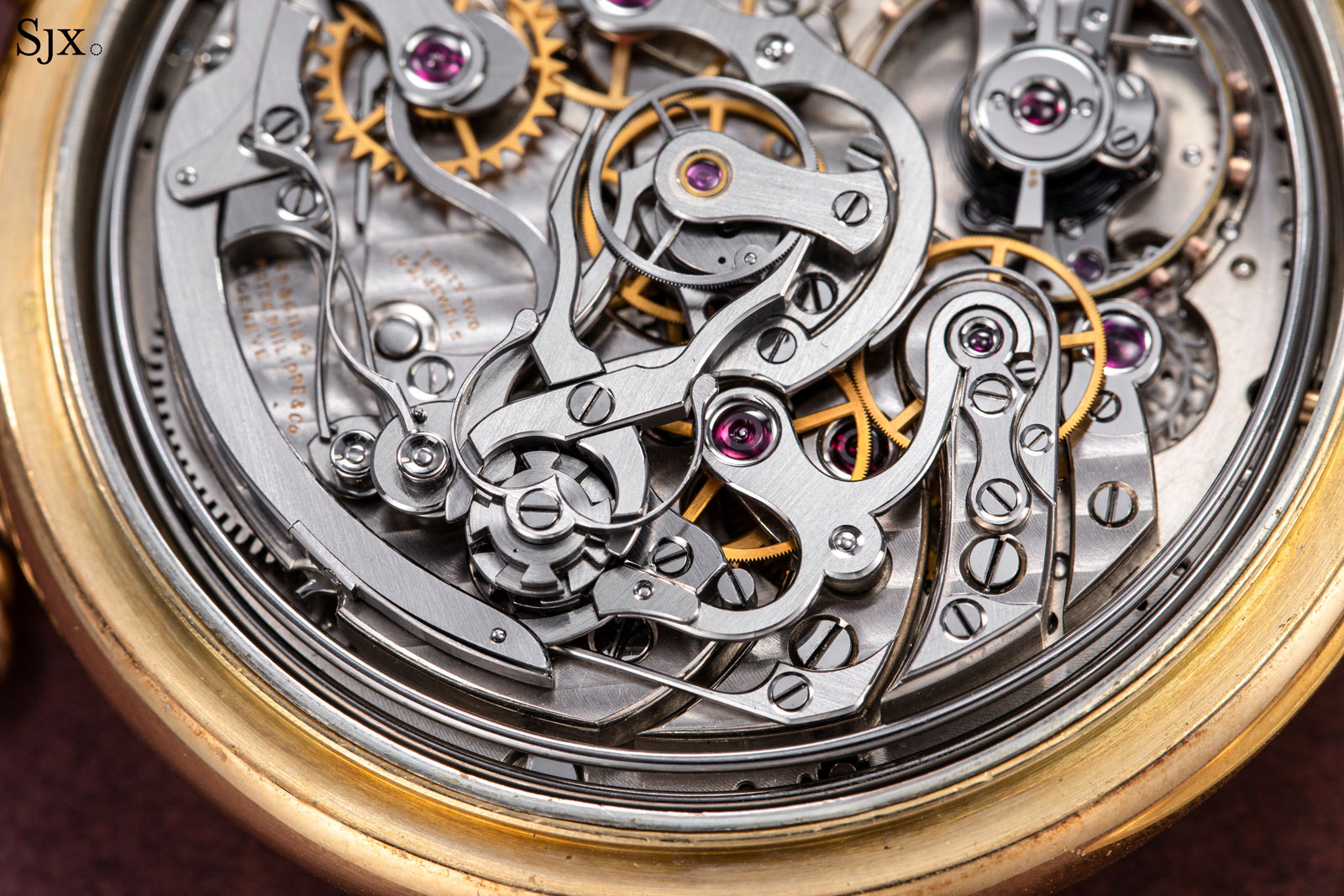
The two-level column wheel
Because this is a grande complication, the base movement below the chronograph incorporates the minute repeating function. Even though the chronograph mechanism covers a good part of the base calibre, the familiar and classical architecture of the striking mechanism is apparent, including the pair of flat-polished steel hammers.

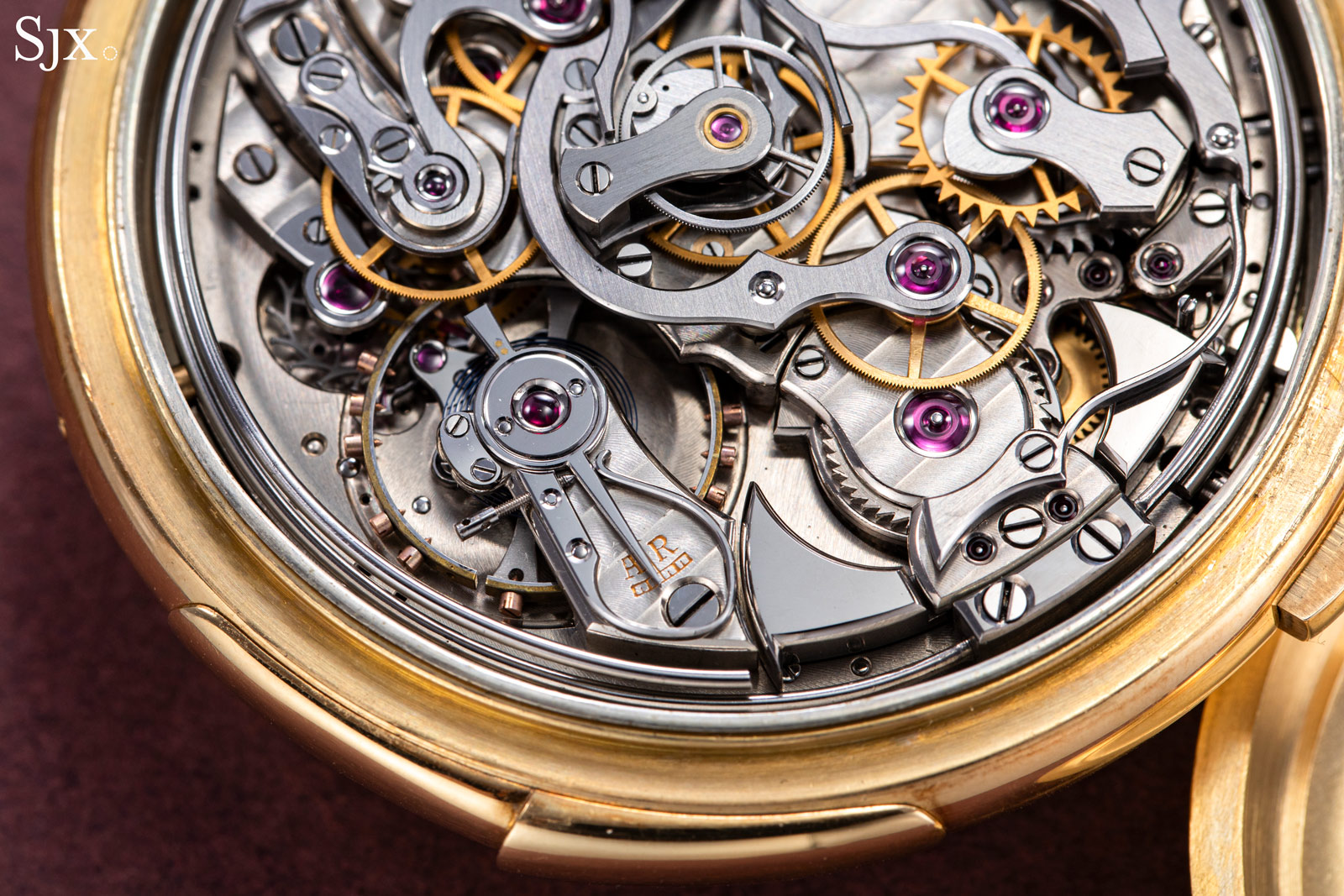
The ref. 767 with double split-seconds is lot 862 in the Phillips Hong Kong auction taking place on May 24 and 25. It has an estimate of HK$3.2-6.4 million, or about US$410,000-821,000. For more, visit Phillips.com.
Clarification May 16, 2024: The double split-seconds or triple-split complication is unique for Patek Philippe, but not amongst pocket watches in general.
Back to top.
